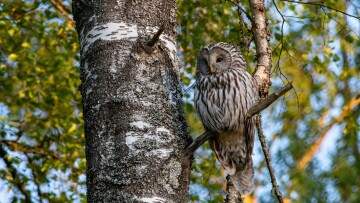Telomere length in relation to colour polymorphism across life stages in the tawny owl

The article has been published in Journal of Avian Biology on 2.12.2020. The article can be found on this link: https://doi.org/10.1111/jav.02564
Abstract
Telomere erosion has been proposed to be tightly associated with senescence, environmental stressors and life history trade‐offs. How telomere dynamics vary across life stages and especially in relation to (heritable) phenotypic traits is still unclear. The tawny owl Strix aluco display a highly heritable melanin‐based colour polymorphism, a grey and a brown morph, linked to several fitness traits including morph‐specific telomere dynamics. As adults, brown tawny owls have shorter relative telomere length (RTL) and exhibit faster telomere shortening rate than grey owls. Here we test if these morph‐specific telomere dynamics emerge already during growth, or if they are induced only in adult life through differential physiological costs associated with the life history of the morphs. We analysed RTL from 287 tawny owl offspring and 81 first breeding adults to evaluate at what life stage morph‐specific patterns emerge. We found no differences in RTL between the two morphs during the nestling period nor at the first breeding attempt. Sex, brood size or size rank in the nest did not affect offspring RTL. Among first‐breeders, females had shorter telomeres than males suggesting a sampling‐time dependent difference in reproductive costs between sexes, due to the prominent sex roles in tawny owls in the early nestling period. The probability to return to breed after the first breeding attempt was not affected by RTL, sex or colour morph. The lack of morph‐specific difference in RTL among nestlings and first breeders suggests that previously observed morph‐specific differences in RTL dynamics in adults emerge at the onset of the breeding career and is likely due to different physiological profiles and life‐history strategies adopted by adults. We conclude that different telomere dynamics and senescence patterns among highly heritable phenotypes (colour morphs) are likely to be a result of differential costs of reproduction and self‐maintenance.
Photo: Unsplash.